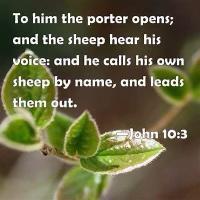Ahora tenemos que darle forma a lo que algun@s han comenzado a llamar; La Iglesia en Casa. Aunque yo me sigo preguntando; ¿qué hacen quienes no tienen un hogar? Por esto a la misma vez, estoy declarando desde hoy en nuestra Iglesia Santa Cruz una jornada de cuaresma de oración, ayuno y leer la Biblia en el Tiempo del Coronavirus.
Sheep will not follow a stranger, but will flee from someone whose voice they do not recognize

Reading: The gatekeeper opens the gate for him, and the sheep listen to his voice. He calls his own sheep by name and leads them out. John 10:3.
Good morning, happy Monday, and many blessings.
The focus of today’s Gospel (John 10:1-10) is on Jesus as the door or gate of the sheepfold. Admittedly, the image of Jesus as shepherd makes for a far more natural comparison than comparing Jesus to a gate. And how can Jesus be both at the same time? These two images are part of a richly layered, extended metaphor that speaks of sheep, shepherd, gate, gatekeeper, strangers, thieves, bandits, and wolves. All of these except for the wolves are introduced in the first ten verses, and all of the elements of this extended metaphor contribute to understanding who Jesus is, and who we are in relation to him.
Jesus begins by describing who he is not. Those who climb into the sheepfold in a furtive way are thieves and bandits who do not care about the sheep but only about their own gain (10:1). By contrast, the shepherd enters the sheepfold openly, by means of the gate (10:2). He is recognized immediately by both the gatekeeper, who opens the gate for him, and by the sheep, who know his voice (10:3). When he calls his sheep by name, they follow him, and he leads them out to pasture (10:4). The sheep will not follow a stranger but instead will flee from one whose voice they do not recognize (10:5).
Rather than change tactics, Jesus “doubles down” on this figure of speech, saying to them, “Very truly I tell you, I am the gate for the sheep” (10:7). He describes all who came before him as thieves and bandits to whom the sheep did not listen (10:8). Again, Jesus says, “I am the gate,” and then adds: “Whoever enters by me will be saved, and will come in and go out and find pasture” (10:9). Whereas “the thief comes only to steal and kill and destroy,” Jesus says, “I came that they may have life, and have it abundantly” (10:10).
The function of the gate is to keep the sheep together in the sheepfold during the night, safe from thieves and predators. During the day, the gate is opened so that the sheep can go out, following their shepherd, to find pasture. The gate and the shepherd work together for the well-being of the sheep, so that the flock thrives. Jesus is both the gate and the shepherd at the same time; he guards and protects his sheep from danger, and he provides for their nourishment, for their life in abundance.
Although there is no one-to-one correspondence between elements of the metaphor and the narrative it follows, certain associations are hard to miss. The Pharisees who have interrogated the blind man in John 9 are supposed to be the shepherds of Israel, those who care for, protect, and nourish the people. Instead, they expel the healed blind man from their community, refusing to believe that Jesus and his healing work come from God. They are more concerned about guarding their power and authority than about the well-being of the people.
Another direction for reflection on this text might be to ask: What does it mean for us as followers of Jesus today, in our context, to be protected by the gate and the shepherd, to be “saved,” to have life in abundance? Do we recognize the voice of the good shepherd over all the other voices promising abundance?
Blessings,
Fr. Luis+
- Inicie sesión para comentar
